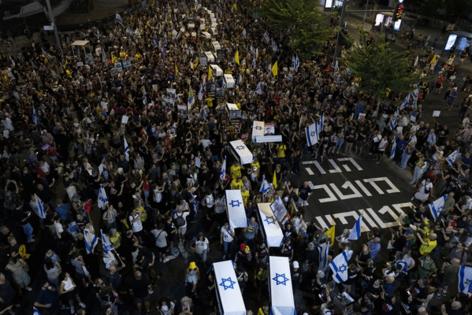US still pushing Gaza cease-fire deal as Israel and Hamas dig in
Published in News & Features
About three months ago, U.S. President Joe Biden said Israel and Hamas faced a “decisive moment” when he proposed a cease-fire deal to pause their devastating war in Gaza.
His administration, despite repeated setbacks, is still pushing for an agreement and trying to end a deadlock as the war nears the one-year mark.
The U.S. will present Israel with a new proposal in the coming days, Secretary of State Antony Blinken said Thursday, while Egypt and Qatar, which are coordinating with Washington, will share it with Hamas.
“And then it will be time, really, for the parties to decide — yes or no,” Blinken told reporters during a briefing in Haiti.
He said that 90% of the deal had been agreed upon, similar to his mid-July description of the talks as “inside the 10-yard line and driving toward the goal line.”
His comments came only hours after Israeli Prime Minister Benjamin Netanyahu struck a gloomy tone, saying a deal is “not close.” Hamas “don’t agree to anything,” he said, adding that Israel has no choice but to keep its forces along the border between Gaza and Egypt, known as the Philadelphi corridor. That’s become a key sticking point in recent weeks.
The negotiations have been characterized by overly optimistic rhetoric from U.S. officials, including Biden and Blinken, while the prospects for an agreement remain dim, said Hussein Ibish, a senior resident scholar at the Arab Gulf States Institute.
“It’s more idealistic than anything else,” he said. “It’s starry-eyed. It’s pie in the sky.”
The death of six hostages over the weekend seemed to show the Iran-backed group’s stance is hardening. That’s been evident from the most recent talks, according to two Middle East-based officials following them. Earlier, it was willing to make concessions, the officials said.
The killings of the hostages — Israel says they were shot in the head from close range — has caused Israel to dig in as well, leaving both sides now unwilling to budge, said the officials, who asked not to be identified given the sensitivity of the negotiations.
Before then, the talks were already tangled over the Philadelphi corridor and details such as how many hostages Hamas would release in the first phase of a deal and which Palestinians would be freed from Israeli jails.
A senior Biden administration official, briefing reporters on Wednesday, confirmed that the hostage killings have made the negotiations even tougher.
During talks in Doha last week, Israel was considering the release of about 800 Palestinians in exchange for the hostages, said the U.S. official. That must now essentially be reworked, they said.
The killings may also disrupt a potential solution to the issue of the Philadelphi corridor. An Israeli official familiar with the negotiations said the U.S. will suggest that Israel only keep troops along a portion of the border — between the Rafah crossing, Gaza’s main conduit to Egypt, and Kerem Shalom, which connects to Israel. The development was first reported by Israeli newspaper Yedioth Ahronoth.
However, Netanyahu on Thursday said Israel will now take a tougher stand.
“I have red lines,” Netanyahu said in a Fox News interview. “They’ve become redder” after the killings.
“To go and make concessions after these murders? It’s a license to kill hostages,” he said. “That’s what Hamas will understand: Kill hostages, get concessions.”
The group, designated a terrorist organization by the U.S. and European Union, is now led by Yahya Sinwar, its Gaza military head and architect of the Oct. 7 massacre and kidnappings in southern Israel that started the war. He was appointed overall leader after its political chief, Ismail Haniyeh, was assassinated in Tehran in July. Iran and Hamas blamed Israel, which has neither confirmed nor denied being responsible.
Deter Iran
A deal would ease regional tensions, particularly between Israel and Iran, as well as between Israel and Hezbollah, a Tehran-supported militant group that’s been firing on Israeli territory from Lebanon in solidarity with Hamas. It would also allow the U.S. to bring back some of the military assets it’s deployed to the region, a posture that can’t be sustained indefinitely.
Those U.S. resources, including two aircraft carrier groups, were sent primarily as deterrence against Tehran, which had threatened to strike Israel, and to stop a major assault by Hezbollah, the Middle East’s most powerful non-state actor.
The two carrier groups — the Roosevelt and Lincoln — are “considered to be a surge capability,” said Michael Eisenstadt, director of The Washington Institute’s Military and Security Studies Program. The navy aims for deployments to only last six months, he said, and “after a while, you have diminishing returns.”
In a sign the U.S. isn’t wholly confident of getting Hamas and Israel to reach a deal, it’s preparing for a possible collapse of the ceasefire talks and higher regional tension, General Charles Q. Brown, chairman of the U.S. Joint Chiefs of Staff, told the Financial Times in an interview.
—With assistance from Fiona MacDonald, Natalia Drozdiak, Iain Marlow and Ethan Bronner.
©2024 Bloomberg L.P. Visit bloomberg.com. Distributed by Tribune Content Agency, LLC.







Comments